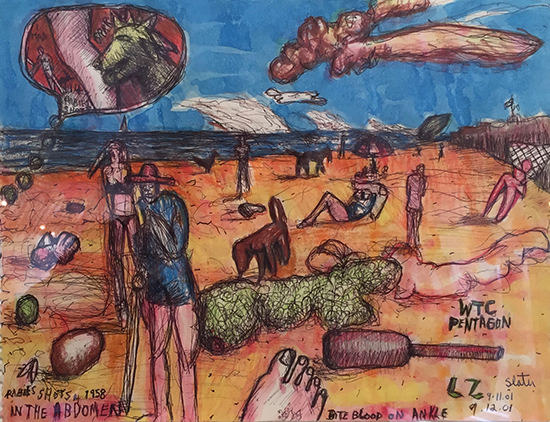Elementally, David Slater’s artwork has always revolved around the premise of narrative as an integral component in the painterly process. Conveying content through the use of personal details and symbols that offer intimations of profound though ambiguous meaning, the artist conjures stories absent the proclivities of a painter who might attempt to dictate to the viewer how to respond specifically to the imagery itself. He is able, in essence, to skillfully reflect the philosopher Hannah Arendt’s dictum that “storytelling reveals meaning without committing the error of defining it.”
Slater accomplishes this feat through his use of juxtapositional contrast of both painterly and collage images and words, constructing a compositional framework that allows information and imagery to coexist as equal parts of the painterly persona.
At the same time, perhaps echoing Francis Bacon’s search for “deeply ordered chaos,” Slater builds his narrative in a manner that is never predictable. This allows the storyline to evolve from a mélange of images that, in their exuberant cacophony, often gives the narrative the sense that it is in danger of veering out of control. In fact, though, this multiplicity of images simply serves the artist’s desire to visually express what Paul Simon called, in the song “Boy in the Bubble”: “staccato bursts of constant information.”
Slater's paintings are currently exhibited in the solo show "Dreams, Ghosts and Blue Moonson" at Peter Marcelle Project in Southampton, N.Y.
On at least one level, viewers can gain some measure of understanding of the context of David Slater’s paintings if they are at all familiar with the physical aspects of downtown Sag Harbor. N.Y. This is notable in works such as January Blue Moon (acrylic, mixed media on paper, 1999), March Blue Moon (mixed media, gouache on paper, 2001), or November Blue Moon (acrylic, mixed media on paper, 2003), all of which use well known local buildings and storefronts as touchstones from which the rest of the work’s narrative impulse seems to take its cue.
.

"January Blue Moon" by David Slater, 1999. Acrylic and mixed media on paper.
.
Even within these examples, though, the ambiguity of the artist’s narrative intent maintains an elusive measure of mystery that can almost never be completely divined. In the aforementioned January Blue Moon, for example, two prominent collage components refer to James Joyce’s seminal modernist novel, “Ulysses,” leaving the viewer to attempt to discern their meaning within the context of the work itself.
Certainly, the stream of consciousness and experimental prose found in the novel has a certain parallel imagery in the structure of the painting, and, much like Slater, Joyce strove to create a sense of order from a reality that was, at least superficially, distinctly unstructured and chaotic.
.

"March Blue Moon" by David Slater, 2001. Mixed media on paper.
.

"November Blue Moon" by David Slater, 2003. Acrylic and mixed media on paper.
.
This compelling narrative opacity is also notable in the work The Ties That Bind (oil on canvas, 1984) that depicts a markedly bucolic scene featuring a wood burning stove, a cat, and other images of gentle domesticity. This sensibility is, however, countered by the Fauve-like wild coloration and use of playful geometric elements that Slater uses in the work, as well as the scrawled inscriptions around the edges of the canvas. These include the title itself, as well as other phrases, including “The Long Way Home” and “Colder Than a Witches Tit.”
.

"The ties that Bind" by David Slater, 1984. Oil on canvas.
.
This ambiguity is also apparent in the most obvious work in the exhibition. Titled Day of the Disaster (ink and gouache on paper, 2011) this piece includes specific references to the 9/11 World Trade Center bombing and is explicitly dated 9/12/01. But even had the artist left out the specific references to that horrific event, the viewer would nevertheless still be left with overtones of foreboding and disquiet in the artist’s use of elongated, almost tortured figuration, and cloud formations that seem less like organic objects than vengeful wraiths intruding on the serenity of the deep blue sky.
.

"The Day of the Disaster" by David Slater, 2011. Ink and gouache on paper.
.
________________________________
BASIC FACTS: “David Slater: Dreams, Ghosts and Blue Moons” is exhibited through January 3, 2016 at the Peter Marcelle Project, North Main Street, Southampton, NY 11968. 631-613-6170; www.petermarcellegallery.com.
________________________________
Copyright 2015 Hamptons Art Hub LLC. All rights reserved.
